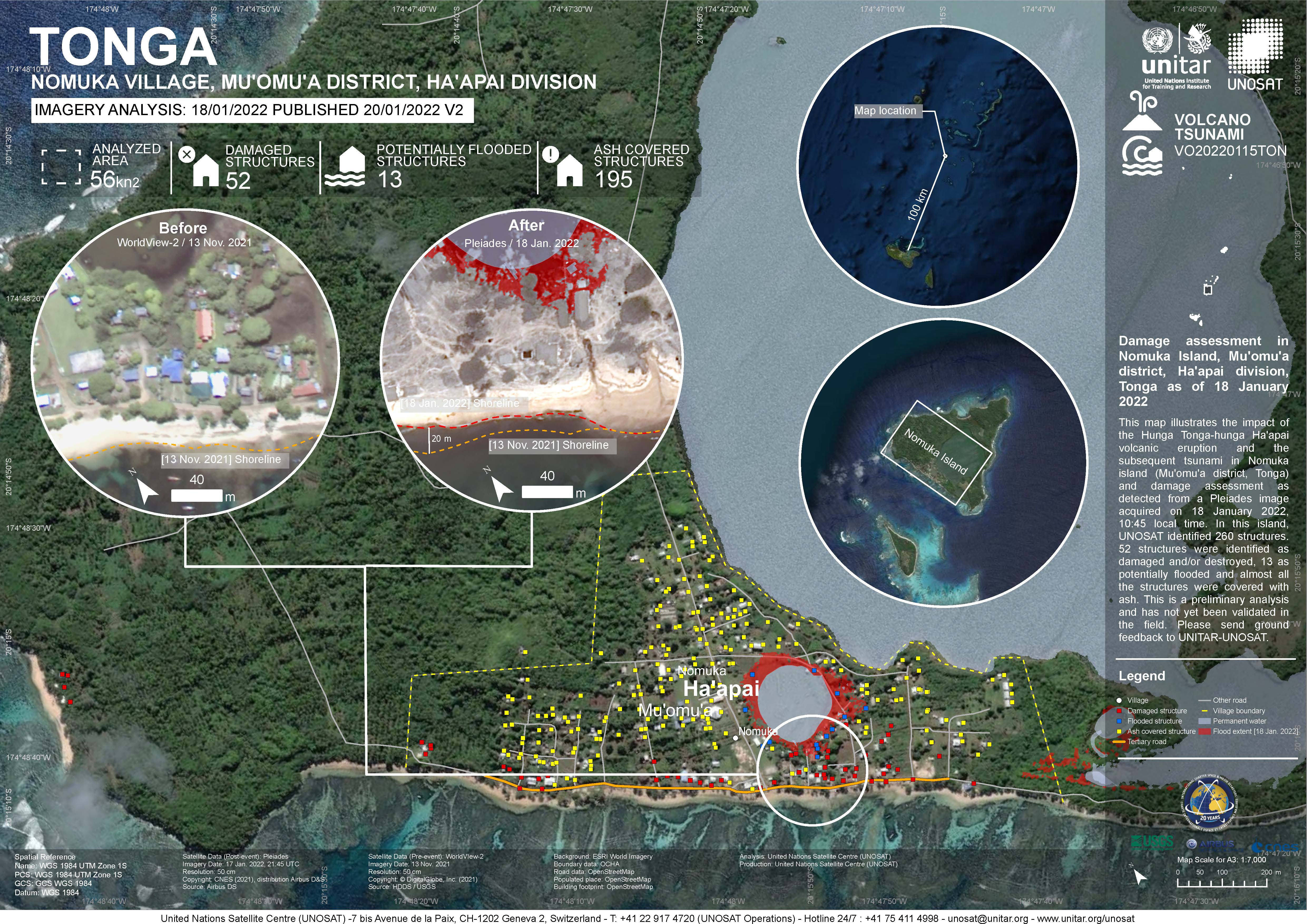The increased demand for high quality products in export markets, coupled with Pacific Island Countries (PICs) national desire to protect the environment, biodiversity and family farming structures, lead to assume that organic agriculture could offer good prospects for PICs development. Besides market opportunities, organic agriculture could increase PICs food self-reliance and thus, contribute to reducing the alarming trend of dependency on food imports, as well as improving nutrition.
Damage assessment as detected from a Pleiades image acquired on 18 January 2022 in Nomuka Island (Mu'omu'a district, Tonga).
260 structures identified, 52 structures were identified as damaged and/or destroyed, 13 as potentially flooded and almost all structures were covered with ash. This is a preliminary analysis and has not yet been validated in the field

Most atoll ecosystems and a wide range of terrestrial and marine organisms, and genetic or cultivars varieties of
traditional food and other multi-purpose plants are declining in abundance and under threat of either “economic extinction” or extirpation and in need of some form of protection. The severity of the situation is greatest on those more urbanized atolls where both the biodiversity and the local knowledge of biodiversity are threatened.
*see R Thanman pdf report for more information*
Terrestrial and marine plants and animals that are rare, endangered or in short supply,
and in need of protection in the atolls of the Pacific Islands.
This excel file include four spreadsheets each representing a separate theme (EMG = Environmental Monitoring and Governance, IOE = Island and Ocean Ecosystems, CCR = Climate Change Resilience, WMPC = waste). Within each theme are the core national environment indicators (scrolling from left to right).
Metadata file for the GIS data (raster and shapefiles) for the global threats to coral reefs: acidification, future thermal stress, integrated future threats, and past thermal stress.
Metadata file for the GIS data (raster and shapefiles) for the local threats to coral reefs: coastal development, integrated local, marine pollution, overfishing, and watershed pollution.
Excel file with spreadsheets for each species. Downloaded from TREDS May 2021.
This review was in preparation for Tonga's 4th national report to the CBD (Convention on Biological Diversity)
Official DKAN data portal user manual.
The Integrated Water and Coastal Management Plan for Vava'u acrhipelago in the Kingdom of Tonga has involved consultations with multi-level and multi-discipline stakeholder including local, provincial and national institutions, civil societies, private institutions and communities.
The Integrated Water and Coastal Management (IWCM) project was initiated in 2013 as a continuation of the very successful Integrated Water Resource Management Project in Vava'u from 2010-2012.
The deliverable focuses on a categorized listing of key issues and available information plus a concise description of the major characteristics of the Tongatapu coast (see Appendix B). The evidence to support the recommendations presented in this report has been gathered from a literature review, interviews with key stakeholders of Tongan government agencies and consideration of existing institutional practices of coastal management planning from the international arena (see Deliverable 2).
Rising oceans, changing lives: Final report is the overview report in a series of technical reports that have been
written for the project on Lifuka Island. Accordingly the section titles in the final report correspond with the
names of the respective technical reports.
This was an integrated effort by all concerned with the coastline in Tonga.
Integrated Coastal management applied conscious management process that acknowledge the interrelationships among most coastal and ocean uses and the environment that potentially affected.
A presentation by Mr Taaniela Kula - from the "Groundwater Governance: a Global Framework for Action"